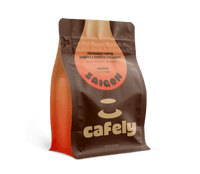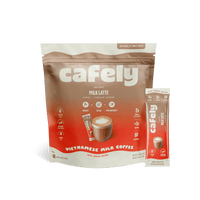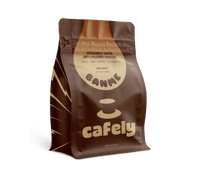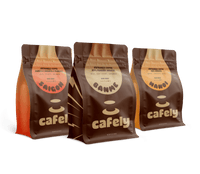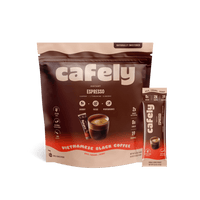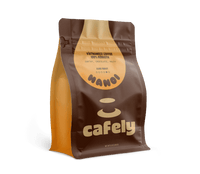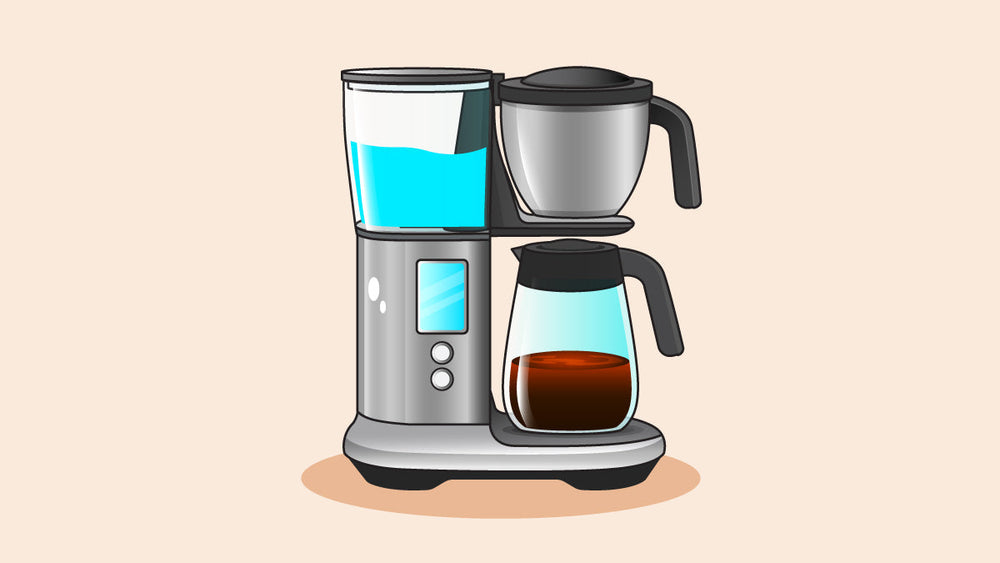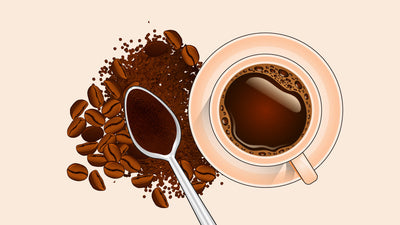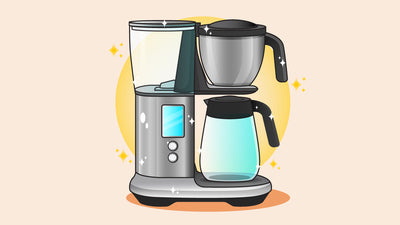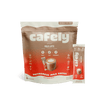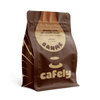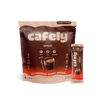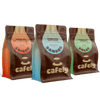The drip coffee machine epitomizes convenience and quality in coffee brewing.
These straightforward, function-first coffeemakers are a staple in North American homes. They employ an automated pour-over method — dripping hot water slowly over ground coffee to produce a clean, consistent, and flavorful brew.
Drip coffee brewing is straightforward and automatic, but you can still customize the taste and texture of your coffee by playing with the grind size and ratio of your coffee.
Here's how to brew the perfect cup using an automatic drip coffee maker.

Drip Coffee Specs
- Brew Time: 5-10 minutes (varies by model)
- Coffee/Water Ratio: 1:16
- Grind: Medium (like sea salt)
- Water Temperature: 195–205°F (90–96°C)
- Recommended Coffee: DaLat Coffee
Drip Coffee Brewing Summary
- Load your drip coffee machine with a fresh filter
- Fill your water tank to the fill line
- Measure & grind your coffee
- Start the machine
- Pour, sweeten, & enjoy
Tools You’ll Need
To brew coffee using a drip coffee maker, you’ll need the following items/ingredients:
- Drip Coffee Machine — These automatic coffee machines come in all shapes and sizes. Opt for something with a metal or glass carafe (insulated is ideal but not required) and a timer to schedule your brewing to match your morning routine.
- Coffee Filters — Available in paper, metal, or cloth versions, depending on your preference and the design of your coffee maker.
- High-Quality Coffee — The foundation of a great cup of coffee. Grind your own for a fresher cup, or buy pre-ground to skip this step entirely.
- Coffee Grinder — A burr grinder will provide the best grind consistency, but a blade grinder or a small blender will do the trick too. Aim for a medium grind with a consistency similar to sea salt.
- Water — Use filtered water whenever possible to prevent mineral deposits from damaging your machine over time.
Step-By-Step Instructions: Drip Coffee
Here’s a simple process for brewing coffee using a standard drip coffee maker. Note that models can vary by manufacturer — so read the instructions with your brewer for specific guidance.
Step 1: Prepare the Coffee Machine

Ensure your coffee machine is clean and free from old grounds or residue. Regular cleaning prevents off-flavors and maintains the quality of your coffee.
Place the filter inside the filter basket. Fill the water reservoir to the fill line, or use the included carafe to pour the perfect amount of water for your device.
Step 2: Measure & Grind Your Coffee

For the best taste, use freshly ground coffee beans. Measure 1 gram of coffee for every 16 grams of water. The grind should be medium, akin to sea salt. This ensures optimal extraction without over- or under-extracting the coffee.
Coffee to Water Portions for Common Drip Coffee Maker Sizes
|
Coffee Maker Size |
Servings |
Coffee |
Water |
|
2-Cup Coffee Maker |
1–2 servings |
4 tablespoons (28 grams) |
2 cups (470 mL) |
|
4-Cup Coffee Maker |
3–4 servings |
8 tablespoons (56 grams) |
4 cups (950 mL) |
|
6-Cup Coffee Maker |
5–6 servings |
12 tablespoons (84 grams) |
6 cups (1.4 L) |
|
8-Cup Coffee Maker |
7-8 servings |
16 tablespoons (112 grams) |
8 cups (1.9 L) |
|
10-Cup Coffee Maker |
9-10 servings |
20 tablespoons (140 grams) |
10 cups (2.2 L) |
|
12-Cup Coffee Maker |
11-12 servings |
24 tablespoons (168 grams) |
12 cups (2.8 L) |
Step 3: Brew

With the coffee in the filter and water in the reservoir, turn on your machine. The water will heat up automatically and drip over the coffee grounds.
Drip coffeemakers can take anywhere from 2–10 minutes to complete.
Step 4: Sweeten & Enjoy

Once your coffee is done brewing, flavor with milk, milk your favorite milk alternative, or sugar and enjoy!
It’s best to serve your coffee immediately for the best flavor. Coffee left on a warmer can become bitter over time.
Expert Tips & Tricks: Drip Coffee
Automatic drip coffee brewers are already designed to make brewing an excellent cup of coffee as simple as possible. There isn't much nuance to making coffee with these machines, but there are a few things you can do to get the most out of your beans.
1. Water Quality Matters
Use fresh, cold water. If your tap water tastes off, it will affect your coffee. Consider using filtered or bottled water.
If your water is particularly hard, it's wise to use filtered water to avoid mineral buildup in your machine, which can clog the shower head. If this happens, you can clean your device by running it once with white vinegar instead of water.
2. Experiment with Coffee:Water Ratios
Most coffee makers call for a ratio of around 1:16 coffee to water — but feel free to play around with this to find the perfect cup for your preference. Less coffee makes a milder cup, while more produces a bolder, darker brew.
You can also play around with the grind of your coffee. Coarser grinds make weaker coffee; finer grinds produce a thicker, bolder cup.
3. Grind Your Own Coffee
Pre-ground coffee works perfectly fine in an automatic coffee brewer — but this extra step of grinding your own beans produces a much brighter, fresher cup. It's a simple step if you have access to a decent-quality grinder, but it makes a big difference — trust us. Keeping the coffee grinder clean with regular maintenance also helps preserve the flavor and aroma of every brew.
5. Pre-Wet Your Filter
Paper filters impart a subtle paper taste to the final coffee. Some people like this added flavor, but if you dislike the idea of subtle papery notes in your coffee, the simple solution is to give the filter a quick rinse with hot water before adding your coffee grounds.
Just make sure the carafe is placed below before you rinse and dump the water runoff before brewing your coffee.
History of the Drip Coffee Machine
The first patent for the automatic drip coffee machine was awarded to Melitta Bentz in 1908. This German entrepreneur also came up with the idea of the paper filter — revolutionizing coffee brewing by making the process cleaner and significantly easier overall.
Over the decades, the drip coffee machine has evolved substantially with technological advancements like integrated timers, programmable settings, built-in grinders, water filtration systems, carafe heaters, and automatic shut-off features.
The electric drip coffee maker exploded in popularity in the United States in the 1970s with the introduction of the Mr. Coffee machine. It resonated with the demands of the busy American worker who wanted a consistently delicious cup of coffee in a quick, convenient manner.
Drip coffee machines are the most common coffee makers today but are on the decline. Data provided by Statista reveals that the drip coffee maker is the brewer of choice by roughly 33% of Americans — down from 77% in 2010.
FAQs & Troubleshooting: Drip Coffee

1. What type of coffee grind is best for drip coffee makers?
A medium grind is ideal for most drip coffee makers. This grind size allows for optimal extraction without the risk of over-extracting or clogging the filter. If your coffee tastes too bitter or too weak, adjusting the grind size to slightly coarser or finer, respectively, may help.
2. How much coffee should I use in a drip coffee maker?
A general guideline is to use 2 tablespoons of coffee for every 1 cup of water. This ratio can be adjusted based on personal taste preferences. For stronger coffee, add more grounds, and for a lighter brew, use less.
3. What is the ideal brewing temperature for drip coffee?
The ideal brewing temperature for drip coffee is between 195 and 205°F (90–96°C). Maintaining this temperature range ensures optimal extraction of coffee flavors without extracting bitter compounds. Most drip coffee machines will automate water temperature for you — high-end models like the Technivorm Moccamaster are especially known for their precise temperature control and consistent brewing performance.
4. Why does my drip coffee taste bitter?
Coffee bitterness can be caused by over-extraction, which occurs when water contacts the coffee grounds for too long, or the coffee grounds are too fine. Make sure your coffee machine isn’t clogged, use less coffee, or turn the temperature setting down on your device to reduce bitterness. The type of coffee also contributes to bitterness — a light or medium roast arabica will have the least bitterness overall.
5. Can I use tap water in my drip coffee maker?
While tap water can be used, the quality of your coffee may improve with filtered or bottled water, especially if your tap water has a strong taste or odor. Hard water can also lead to mineral buildup in your machine, affecting its performance and the taste of your coffee.
6. How often should I clean my drip coffee maker?
We recommend you clean your drip coffee maker once a month to remove hard water deposits (scale), leftover coffee oils, and other debris. However, if you use it heavily, you might need to clean it more frequently.
7. How do I de-scale my drip coffee maker?
De-scaling can be done using a solution of equal parts water and white vinegar. Fill the water reservoir with this mixture and run a half-brew cycle. Pause for an hour, then resume the cycle. Finish by running a cycle or two with just water to rinse away any lingering vinegar taste.
8. Can I pre-grind my coffee for the week?
While grinding coffee just before brewing is recommended for the freshest taste, you can pre-grind your coffee for convenience. Store your ground coffee in an airtight container at room temperature, away from direct sunlight to preserve its flavor as much as possible.
9. Why is my coffee not hot enough?
If your coffee isn't hot enough, your coffee maker's heating element may be malfunctioning. There could also be scale buildup affecting its performance. If the issue persists, making coffee without a coffee maker is another option, such as using a French press, pour-over, or even a simple saucepan on the stove.
